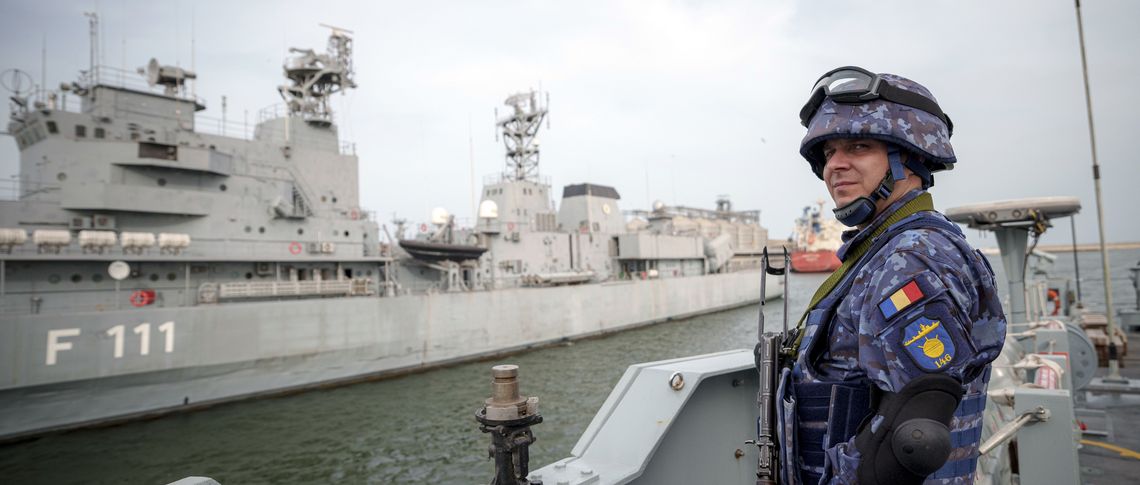Russia’s full-scale invasion of Ukraine in February 2022 has irrevocably transformed Europe’s geopolitical landscape, thrusting the Black Sea region into the foreground of strategic planning. Few countries feel the tremors of this shift more acutely than Romania. From Bucharest’s perspective, the war confirmed a longstanding suspicion that Russia harbours revisionist ambitions inimical to regional stability.
Yet, while Romania’s alarm over Russian aggression is by now widely shared among its NATO allies, Romanian policymakers still grapple with a daunting set of constraints in the Black Sea. Chief among them is the reluctance of certain NATO members to adopt a unified, assertive approach – owing to historical, domestic and diplomatic reasons – and the enduring legal limitations imposed by the Montreux Convention, which regulates maritime traffic through the Bosporus and Dardanelles straits in Türkiye.
Despite these challenges, Romania sees in the current crisis an opportunity to reimagine the Black Sea’s security architecture through deeper defence cooperation, enhanced deterrence, and a concerted push for stronger US and NATO engagement.
A strategy for the Black Sea
Romanian foreign policy elites have, for years, viewed Russia’s annexation of Crimea in 2014 as a watershed moment revealing the Kremlin’s willingness to upend the post–Cold War order. In Bucharest’s eyes, that aggression was not a one-off violation but part of a sustained campaign to reassert Russian influence along its southwestern flank. The later, full-scale assault on Ukraine, with its attendant naval operations in the Black Sea, only hardened Romania’s conviction that Russia must be countered robustly. The Romanian public largely supports this stance: polls consistently show a pro-Western outlook and a keen sense that Moscow poses an existential threat to the country’s sovereignty, notwithstanding recent support for far-right candidates with suspiciously pro-Russian positions. That public support has enabled Romanian leaders – across party lines – to champion new defence initiatives and seek a stronger NATO presence.
The war in Ukraine has, in effect, validated Bucharest’s calls for greater vigilance in the region. NATO’s evolving posture, including the creation of multinational battlegroups in Bulgaria and Romania, reflects the Alliance’s growing attention to its south-eastern flank. The expansion of rotational deployments, coupled with investments in intelligence, surveillance and reconnaissance (ISR), underscores a renewed NATO interest in what was once described as a ‘black hole’ of alliance strategy. Romania has welcomed these developments as important steps toward a more robust deterrent posture, particularly since it has long argued for a permanent NATO or US naval presence in the Black Sea.
Romania remains steadfast in its push for stronger multilateral and minilateral cooperation around the Black Sea.
Yet, despite these favourable signals, Romania’s vision of a ‘Black Sea strategy’ that parallels the Baltic Sea model – with a high level of intra-NATO and regional security cooperation – remains elusive. One fundamental obstacle lies in the differing threat perceptions among littoral NATO members: Bulgaria and Türkiye. Bulgaria’s strategic outlook is often shaped by a more ambivalent attitude toward Russia, while Türkiye’s perspective – long conditioned by the Montreux Convention – centres on maintaining its privileged position as the gatekeeper of Black Sea access. Indeed, for decades, Ankara has used the Convention’s provisions to limit large-scale or long-term naval deployments by non–Black Sea states. From Romania’s point of view, this has effectively closed the door to any consistent NATO maritime presence, complicating its ability to deter Russia.
But Türkiye’s control over the Bosporus and Dardanelles also has had strategic advantages for NATO. Over the past year, Ankara enforced restrictions on certain Russian naval movements, indirectly supporting the Alliance’s broader containment goals. This underscores how Romania’s interests can sometimes coincide with Türkiye’s more independent approach. Nonetheless, Bucharest would prefer a more open, coordinated framework for Black Sea security – what some call a ‘Mare Liberum’ – where the entire alliance could share the burden of naval patrols and deterrence. Such a vision clashes not only with the Montreux Convention’s letter and spirit but also with Ankara’s desire to maintain its status as the region’s indispensable maritime arbiter.
Still, Romania remains steadfast in its push for stronger multilateral and minilateral cooperation around the Black Sea. Several initiatives illustrate the country’s commitment to forging deeper ties with neighbours that share its wariness of Moscow’s designs. The Bucharest Nine (B9), for instance, brings together NATO’s Eastern Flank states, providing a platform for strategic alignment on threats. And the Three Seas Initiative aims to bolster infrastructure and connectivity across Central and Eastern Europe — elements that Romania sees as foundational for both economic development and defence logistics. The more integrated regional states are – whether through improved ports, roads or telecommunications – the more readily they can respond collectively to security threats.
What next?
A key question is how the United States will figure in Romania’s evolving security calculus. For Bucharest, American engagement is the central pillar of any durable Black Sea strategy. Romania’s leaders frequently emphasise their ‘strategic partnership’ with Washington, citing missile defence installations (such as the Aegis Ashore site in Deveselu) and a robust record of cooperation in multinational deployments. By positioning itself as a reliably pro-American ally, Romania hopes to secure not only US military backing but also sustained diplomatic support in its bid to shape the regional security environment. Indeed, Romanian officials have signalled that they view increased American economic investment as a way to further anchor US interests in the Black Sea — a critical component of ensuring long-term US presence.
Yet the 2022–23 surge in transatlantic unity may not endure with Trump in the White House, possibly threatening to reverse or stall the region’s progress toward greater security. This uncertainty puts pressure on Romania – alongside other Eastern Flank states – to develop stronger ties with each other and with leading European powers, such as France, Germany and the United Kingdom. It also accelerates debates over European ‘strategic autonomy’, a concept that has been divisive within the EU. While Romania and its neighbours remain wary of efforts that might side-line the United States, they acknowledge the value of enhanced European capacity in defence manufacturing, procurement and crisis management.
At the heart of Romania’s vision lies an unwavering stance: no concessions to Moscow’s revisionism and no acceptance of a Russian sphere of influence on the Black Sea.
Bucharest’s emerging approach, then, is twofold. First, Romania aims to solidify NATO’s presence in the region through permanent or rotating deployments, stronger joint exercises and closer intelligence sharing. The development of advanced coastal defences – anti-ship missiles, integrated air defences and modernised naval platforms – is part of Romania’s attempt to ensure its readiness, with or without a substantial allied naval presence. Second, Romania is looking to diversify and expand partnerships beyond NATO, especially in the realms of defence production and infrastructure by teaming up with like-minded countries such as South Korea. It recognises that regional security hinges on economic resilience and connectivity, making initiatives that link the Black Sea to the Balkans and Central Europe a crucial strategic priority.
At the heart of Romania’s vision lies an unwavering stance: no concessions to Moscow’s revisionism and no acceptance of a Russian sphere of influence on the Black Sea. This unwavering stance anchors Romania’s diplomatic positions, its calls for NATO unity and its domestic push for military modernisation. The path forward is beset by challenges – from Türkiye’s unique geopolitical calculations to the unpredictability of US politics – but Bucharest has little choice but to persist. An emboldened Russia, unchecked, would imperil not only Romania’s immediate security but also the broader European project of collective defence.
Internally, Romania is facing another major challenge. The cancelled first round of presidential elections of November last year has brought to light political vulnerabilities that could wreck Romania’s painstakingly built stance in the region. New presidential elections scheduled for May 2025 are keeping everyone in Bucharest on their toes. The implications for the country’s foreign policy can be severe and can put an end to the long-standing elite consensus underpinning Romania’s vision for the region.
Romania’s vision for the Black Sea ultimately depends on its ability to persuade both sceptical allies and restless domestic audiences, who are willing to give a protest vote to suspiciously pro-Russian candidates, that the costs of steadfast engagement pale before the dangers of complacency. If it succeeds in this, it may yet transform the Black Sea from a theatre of uncertainty into a pillar of a renewed Euro-Atlantic security framework.






